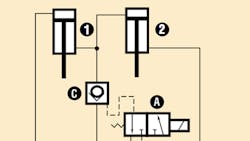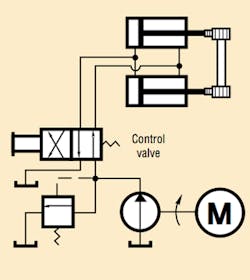Synchronizing circuits
An effective flow divider can be made up of two fluid motors of the same size coupled together. Both motors must rotate at the same speed and, therefore, deliver equal volumes of fluid. Variations in load or friction do not greatly affect synchronization, but motor slip is a factor.
Replenishing
One of the considerations in synchronizing cylinders is leakage replacement. Under normal pressure, leakage can be practically zero over one stroke. Accumulated error is the main concern. A replenishing circuit, which replaces leakage after each cylinder stroke, eliminates this trend. In the circuit, the cylinders are connected in series and controlled by the 4-way manual valve. The cylinders actuate limit switches, which control valves A and B. On the return stroke, if cylinder 1 bottoms first, valve A is actuated to open valve C, permitting excess fluid from cylinder 2 to flow to tank. If cylinder 2's piston returns first, valve B is actuated to direct fluid to retract cylinder 1.
Rack and Pinion
Mechanically tying two cylinders together by installing a rack on each piston rod and fastening the pinions to a single shaft works well when the linkage is rigid and the mesh is proper. A chain and sprocket arrangement can be used if synchronized motion is required in only one direction.



